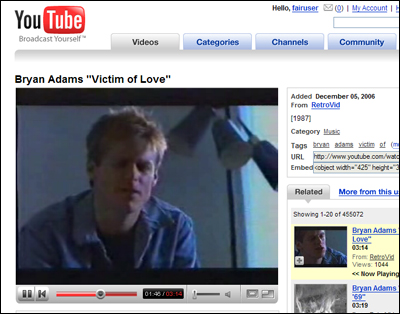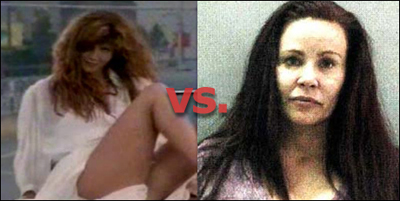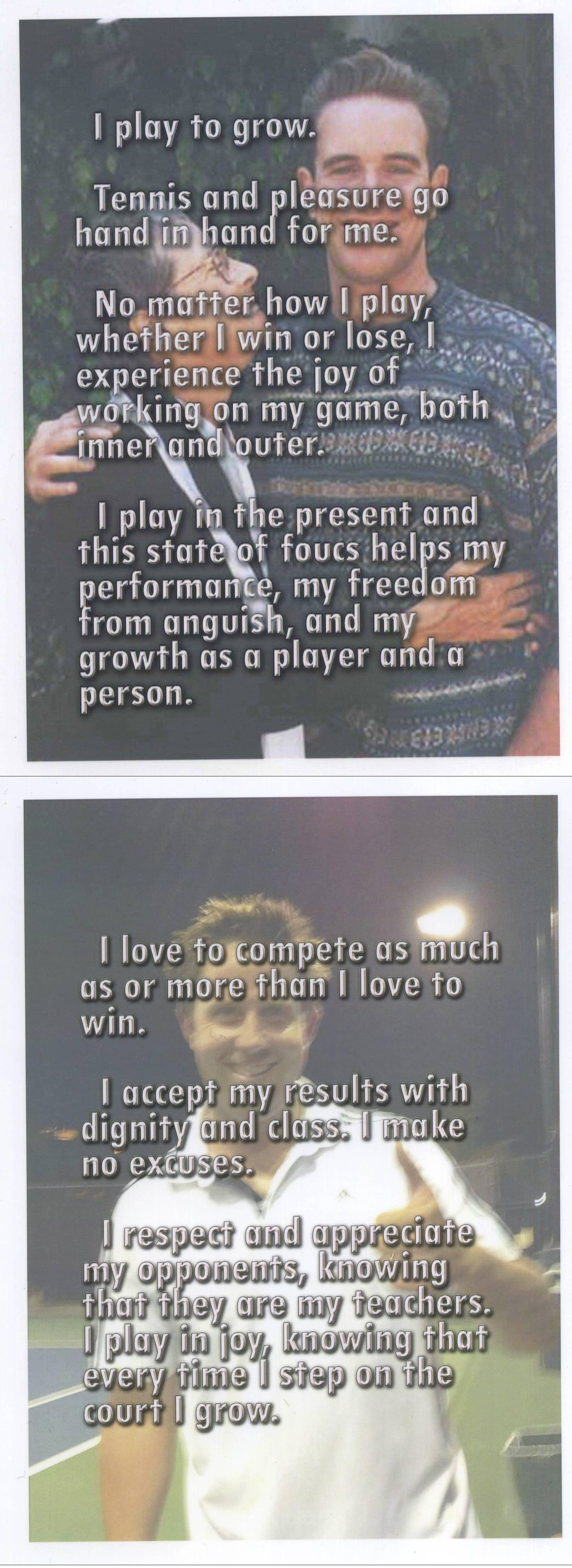“A man cannot free himself from the past more easily than he can from his own body.”
André Maurois
“What came first, the music or the misery? People worry about kids playing with guns, or watching violent videos, that some sort of culture of violence will take them over. Nobody worries about kids listening to thousands, literally thousands of songs about heartbreak, rejection, pain, misery and loss. Did I listen to pop music because I was miserable? Or was I miserable because I listened to pop music?”
Nick Hornsby
“High Fiedlity”
——————
May God be praised for YouTube!
I have recently discovered, much to my surprise and delight, that I can sit in front of my computer in the privacy of my home and via YouTube watch almost any music video ever made for free. I can sit here at my desk late into the night and roam through my memories by watching the music videos of my youth: music I wholeheartedly loved; music I barely tolerated; music associated with key events from my youth — music videos many of whom I have not seen in fully twenty years. The posting of these videos on YouTube breaks a whole host of copyright laws, but the practice seems so rife and so many are doing it that fighting the practice seems futile. When it comes to copyright law and the Internet, the barbarians seem to have broken through the city walls.
I love it!
Why did not anybody develop this earlier? I am more than willing to pay for these videos but had never before been able to find them online or off to do so. Nowadays the only time I go to the file sharing networks to download music is when I cannot buy it at iTunes. If I could buy it, I would; if I cannot, I take it for free. For two years I had searched for Bryan Adams “Victim of Love” video high and low over the Internet with no success. I had not seen the music video since sometime in 1987, and I had seen it only once or twice in total; but it made such an impression on me that I did not forget it, and almost twenty years later I wanted desperately to show it to my students as part of a unit on adolescence, sex, and hormones. I contemplate writing the publishing company and agent to try and get a copy of this video nobody shows. Over several months I had no success finding this video anywhere.
Then, one day I find it with the greatest of ease on youtube. Mirabile dictu!
Then that next week I also discover Facebook! Within a few thrilling minutes, I am able to get back in touch with former students I have been searching for over years. Google search after Google search over several hours no results whatsoever, and then in the space of a few minutes on Facebook I find them all. I was so thrilled finally to find Dani Helfet that I stay up until late in the evening reading up about her life. So many of my former students approach college graduation and legally order a drink at a bar, and within an hour or two I am relatively caught up with them. Via their Facebook profiles I can view dozens of pictures of them and their friends; I can view their current class loads and college majors. My spirits soar and a lump comes to my throat – as a teacher, I even verge on feeling fulfilled to see all my former charges thriving in the world. I re-live happy moments when they were so much younger and sharing their days with me, their teacher.
Who says the Internet is a waste of time!
I return back to YouTube and spend hours searching for Police and Sting videos to send to a childhood friend who loves Sting. I convert the Flash files into mp4 files, burn them all onto two CDs, and mail it all to him as a Christmas present. Talk about the ghost of Christmas past! I search through YouTube for songs that I did not even know had videos made of them, and all too often I find what I am looking for. Amazed, I watch videos of Adam Ant music I have not heard since 1982. I scour my memory for songs from that time, and I find and watch them. I am amazed. Just amazed. Devo. The Smiths. XTC. Depeche Mode. Level 42. RATT. The Fixx. INXS. Whitesnake.
Incredible. Simply incredible.
As is obvious by now, my “formative” years were the 1980s. In terms of pop culture this decade is easy to caricature: there were spandex pants, the big hair, synthesizers, guitar solos, parties, girls – the avatar of this epoch might be David Lee Roth when he was still part of van Halen. Perhaps it is not best to take the time too seriously. The music video was nascent, unpolished – innocent. For better and for worse, this was my time. I remember well all the music – much of it mightily dreadful. But it was the music of my time, and by the early 1990s it was gone to be replaced by new directions and different styles.
The heavy metal and synthesizer music of the 80s went out of style to be replaced by a harder-edged rap and “grunge” music of the next decade. I did then, do now, and always will detest rap music. Music for thugs, glorifying thuggery. I could never understand why it was so popular. As a beginning public school teacher in downtown LA I would look out at my almost entirely minority student population engulfed in their rap music I would think that if their worst enemy – the Ku Klux Klan, or some like group – wanted to harm them they could hardly do worse than get them hooked on rap music and its gang culture glorifying killing and dying for a few square yards of urban sidewalk that nobody owns in the end. I was 25 years old at the time, not much older than my students. But I did not listen to rap music, if I could at all help it. I did not get rap. Hated it. Still do.
And at the same time there was the Seattle “grunge” sound of Nirvana. When Kurt Cobain killed himself in 1994, half of the student body at my school was put on suicide watch. Kurt Cobain, his music, and his decision to kill himself clearly spoke to something deep in my students. I did not get it. I grew up in the 80s, but these kids were growing up in the 90s. Kurt Cobain was a stranger to me. I could relate to very little artistically in the 1990s, and I was too busy to stay on top of new music or new artists. There seemed little from the 90s that would last the test of time.
But I could say the same about the 80s, looking back.
And then, already in my 30s in a new decade after the year 2000, I encountered the pop music of the next generation – the Brittney Spears, N Sync, Cristina Aguilera, the Backstreet Boys, Jennifer Lopez – and it just seemed more of the same. I remember like it was yesterday a hormonally awash 17-year old Jordan Frye amazedly pointing out the virtues of Brittney Spear’s physiognomy: “But Mr. Geib, she is soooo hot!!!” I told Jordan point-blank she was just the latest bimbo-of-the-month, that I had seen dozens of them come and go already in my life, and that in fifteen years nobody would know her name. There would be a new batch of bimbos by then. Does anyone remember Debbie Gibson now? How about Tiffany?
Aware that with such a curmudgeonly attitude I might miss the next Mozart or Louis Armstrong that comes along, I challenge my students every year to clue me in on the next artistic breakthrough: I give them ten minutes at the beginning of any class to play the music and persuade me that contemporary music is not all trash. After several years of the Mr. Geib’s music challenge, I have never yet been persuaded. Some of the music has been interesting but nothing more; most of the music is execrable.
One student even had the gall to come up and play a Michael Jackson video for me and claim that this was an expression of the musical genius of our time; nowadays there were no “geniuses” like Mozart or Louis Armstrong, she explained, and music as experienced today was all about diverting oneself with friends and dancing to the beat – THAT was the genius of contemporary music, she claimed. It was not about music as metaphor for deeper human concerns, or about virtuosity or some kind of “strangeness” that canonical arts brings. Think about it: Michael Jackson as the embodiment of our culture’s artistic genius – what a depressing thought! Listening patiently to her praise Michael Jackson, I sat there silent and incredulous. Watching Michael Jackson sing and dance in the music video “Thriller,” I fought the urge to curse the age I was born into. This is the best we have to offer posterity? I will hope otherwise.
But I don’t begrudge my students their pop music. I really don’t. I try to take it all philosophically. They are the same as I was, and popular music is not essentially any different. But it is a matter of youth, experience, and memory – and so a good deal of mediocre, some awful, and bit of excellent music will forever be wedded to his first kiss, her first heartbreak, and the loss of their virginity that Friday night when the parents were out of town. Pop music is the soundtrack to the narrative of our brutal, wide-eyed, and reckless youth. For all of us the extreme highs and extraordinary lows which make up the hormone roller coaster of youth will forever be associated with this popular tune or that love ballad of the age, no less indelibly than Pavlov’s slobbering dogs were conditioned by the ringing of the dinner bell. It will be hardwired into our brains and will not leave us.
The music will become immortal.
Has it not always been so? Around 1990 I remember my Uncle Tim tearing up suddenly at hearing The Beatles “Julia” at a Thanksgiving dinner table: the music transported him back to some heartfelt moment circa 1970. Two decades later this music opened up strong memories of the past for him, and I strongly suspected there was a woman involved, although he would not say.
Is this not natural?
And even as I entirely lose touch with youth culture and fail to recognize the names of the current crop of pop singers, I do not belittle my students for devoting their best hours to it. This is a stage, and they will grow out of it. They will come to laugh at the excesses of their adolescence and mock its fashion and mores just as I did.
But will they? Did I?
Sitting in front of YouTube, with suddenly the entire repertoire of 80s music videos at my disposal, I am not so sure.
A part of me argues that I should learn from the past to then let go and embrace the eternal present. “Living in the moment means letting go of the past and not waiting for the future. It means living your life consciously, aware that each moment you breathe is a gift,” exclaims Oprah Winfrey, our culture’s TV pop therapist. Nobody less than the Bhudda advises, “The secret of health for both mind and body is not to mourn for the past, not to worry about the future, or not to anticipate troubles, but to live the present moment wisely and earnestly.” Sage and practical advice. Forever optimistic, forever forward looking, forever focused on the next step, forever productive and efficient, the well-adjusted and mature individual seldom looks backward.
With more art and more subtlety, Jan Glidewell explains, “You can clutch the past so tightly to your chest, that it leaves your arms too full to embrace the present.” This makes sense. The past is gone. There is only the now. Be present to the now. The past is forever old and stale, and we should allow it to slough off like a snake sheds its skin, leaving room for the new and the better.
But I cannot do it! For the life of me, I cannot do it!
I am not one of those few that are forever 20 and bounding recklessly into life – forever young, forever looking forward, forever accomplishing – trampling enemy and fate underfoot on my way to “greatness” and “achievement.”
It is different with me. For me rather the refrain from the movie Magnolia rings in my consciousness: “We might be through with the past, but the past ain’t through with us.” That is more my reality.
Why should this be? It is not because I am haunted by unusual events. My past was neither tragic nor triumphant. My past seems very common and unexceptional.
But my past to me is also a precious food, and I feed on it ravenously, even desperately. I sit here watching 80s videos over YouTube, and there are these past moments – so precious, you hold them in your imagination; they live for years, they are food for the hungry – they are gone. Watching these videos, I am transported.
“The first recipe for happiness is: Avoid too lengthy meditations on the past,” claimed Andre Maurois. Undoubtedly he is correct.
But I find it impossible.
October of 1987. July 1988. February 1992. So incredibly intense.
Hormones. Masculinity. Rage. Ecstasy. Despair.
Those were my late teens and early to mid-twenties.
In retrospect, I was thrilled to turn thirty years of age and leave the previous decade behind. I had by then acquired more material resources, built a career, knew myself better, and enjoyed a certain static sense of fulfillment and happiness that I knew not in younger days. I had grown up. I had earned it through pain and patience, and I did not look back at my twenties and see something I wanted to do again.
But……
I sometimes wish I could go back.
If I do not miss the lows or the confusion, I do miss the highs and the exultation. To be young, to feel so alive, to experience the testosterone coursing through my veins! I remember sometimes just having so much testosterone that I wanted somebody to hit me – or I wanted to hit somebody else. Scoff as I might at the folly of youth, I sometimes miss it. The energy to exercise five hours per day; the energy to teach myself Spanish again. Where did it go? I get tired just thinking about doing those things again. Have I achieved contentment of mood by forgoing extremes of happiness and despair? Is to be “mature” to feel more “flat” and dull? To give up the sharp peaks for flat land? Does life become a bit like a stick of gum chewed for too long and become stale?
I sound like a manic-depressive who misses his mood swings and so discontinues his medication, and I am not such. But as nothing human is completely alien to me, perhaps I have a bit of the manic-depressive in me.
Maybe we all do.
The problem is: in the 80s, I didn’t think the times were very good at all! In all honesty, viewed in the sober light of day, I have to admit this fact. I painfully lurched forward, making mistakes and missteps more often than not. I made my way as best I could with so little life experience. But nostalgia gives a warm glow to the past, and we mourn for that person we were and for moments that are lost never to return.
So here I am sitting here watching videos of these bands from my youth. With one Web browser open I listen to the music on YouTube, while with another I use Wikipedia to find out what happened to that band. Time and time again the bio runs more or less like this: “So and so band achieved fame with this song and that, but then found the celebrityhood to be overwhelming and ‘more than I could handle.’” By the 1990s they were back in the small town where they came from and opened a pub or something. Some cases were worse. Aging “has been” singer Adam Ant dated “up and coming” Heather Graham until she became a star, left him behind, and moved on: he was on the way down, she on the way up during their intersection. Lead singer Michael Hutchence of INXS killed himself. Most of these metalers were famous now only for having been famous two decades earlier. Some had bit spots in TV specials. One had the definite feeling that life had been downhill ever since their 15 minutes of fame. By middle age they were “has beens.”
How sad. How tawdry.
Nowhere is this better realized than with dancer/actress Tawny Kitaen. I remember her very clearly from the Whitesnake music videos of the late 1980s. At the time I would have considered her the very epitome of unbelievable sex goddess. Prancing around in a white see through negligee as lead singer David Coverdale sang. In 1987 it has much of the air of sublime and magical. Well, she married Coverdale in 1989 and divorced him by 1991. Kitaen then married baseball pitcher Chuck Finley in 1997 and had two daughters with him and lived in a mansion in my hometown of Newport Beach, CA, of all places. Things then begin to spiral downwards. Arrested in 2001 for vandalizing another woman’s car. Arrested in 2002 for assaulting her husband and then divorced from him. Tawny Kitaen now lives in an apartment in Mission Viejo with her two daughters. Then just two months ago Kitaen was arrested for cocaine possession and enters rehab in exchange for dropping the felony drug charges.
The fantasy, the dream – and then the reality.
THE PROGRESS OF POESY
By Matthew Arnold
YOUTH rambles on life’s arid mount,
And strikes the rock, and finds the vein,
And brings the water from the fount,
The fount which shall not flow again.
The man mature with labour chops
For the bright stream a channel grand,
And sees not that the sacred drops
Ran off and vanish’d out of hand.
And then the old man totters nigh
And feebly rakes among the stones.
The mount is mute, the channel-dry;
And down he lays his weary bones.
———–
TAWNY KITAEN: Then and Now
“The fantasy, the dream – and then the reality.”
“The light of other days is faded, And all their glories past.”
Alfred Bunn




